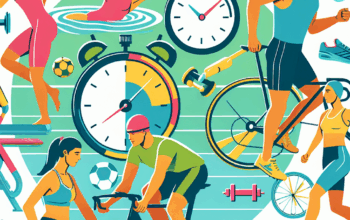How to Safely Return to Play After an Injury
Returning to play after an injury is a critical phase in an athlete’s journey, whether they’re a professional, amateur, or recreational participant. In 2025, as sports science continues to evolve, understanding the nuances of recovery and rehabilitation is vital for minimizing the risk of re-injury. The goal is not just to get back into your sport but to ensure you do so in a way that maintains your overall physical and mental health. This article will provide comprehensive and actionable strategies on how to safely return to play after an injury.
Understanding the Recovery Process
The recovery process after an injury is physically, emotionally, and mentally demanding. First and foremost, it is essential to recognize that injuries vary significantly in nature and severity—whether a sprain, strain, fracture, or chronic injury. Each injury warrants a tailored approach to rehabilitation. Typically, the initial focus is on rest and recovery, ensuring adequate time for the body to heal itself. Ignoring the need for rest can lead to complications and delayed recovery, thus increasing the likelihood of reinjury. Thus, it is crucial for individuals to consult with healthcare professionals, such as physical therapists or sports medicine specialists, who can develop a personalized recovery plan.
The recovery process often follows a phased approach known as the “RICE” principle: Rest, Ice, Compression, and Elevation. Initially, the use of ice to reduce swelling and inflammation is recommended, followed by gradual reintroduction of movement as pain permits. Continuous assessment of the injury is necessary to avoid pushing through pain, which can exacerbate the situation. Furthermore, incorporating range-of-motion exercises early in the process can aid in restoring function as part of a comprehensive rehabilitation program.
Assessing Readiness to Return to Play
Before returning to play, athletes must assess their physical readiness and ensure they meet specific performance indicators. This assessment generally consists of evaluating strength, flexibility, endurance, and proprioception—the body’s ability to perceive its position in space. A thorough evaluation may also include functional tests modeled after the movements specific to the sport in question. For instance, a basketball player might need to demonstrate agility through lateral movements and take jumps, while a soccer player may need to perform sprints and direction changes.
Collaboration with healthcare professionals is crucial during this phase; guidance from a physiotherapist can help identify any gaps in recovery. They often use standardized return-to-play protocols, such as the Functional Movement Screen (FMS) or sports-specific tests, to judge an athlete’s readiness. Additionally, psychological readiness must not be overlooked. An athlete’s confidence and mindset play an integral role in their return; therefore, mental conditioning should be part of the recovery program to ensure athletes can perform without fear of re-injury.
Implementing a Gradual Return-to-Play Program
After assessing readiness, the next pivotal step is designing a gradual return-to-play program. This should ideally involve a structured, progressively intensifying regimen that allows the athlete to regain sport-specific skills while maintaining overall fitness. Start by integrating low-impact activities, such as swimming or cycling, which provide a safe platform for cardiovascular conditioning without excessive strain on the injured area. Gradually, as healing progresses, incorporate sport-related drills that are designed to replicate the demands of the athlete’s specific sport.
A successful return-to-play program consists of three essential phases: rehabilitation, reconditioning, and reintegration. During rehabilitation, the injury is nursed back to health with therapeutic interventions and exercises. Reconditioning focuses on restoring movement quality—incorporating strength training through body weight exercises, resistance bands, or weights that specifically target the weakened area. Finally, reintegration emphasizes full participation in the sport, implementing controlled practice sessions, and gradually moving towards competitive play. Each phase should be adaptable; athletes should progress at a pace that suits their unique recovery timeline.
Creating a Supportive Environment Post-Injury
A supportive home and social environment significantly impact an athlete’s recovery journey. Family members, coaches, and teammates should all understand the rehabilitation process, encouraging a culture of patience and motivation. Encourage open dialogue regarding feelings of frustration or setbacks; this can be especially helpful as athletes often feel isolated when sidelined from their sport. Building a network of support can include regular check-ins from coaches or training partners who can provide encouragement and reinforcement of the athlete’s goals.
Nutrition also plays a vital role in recovery—it is essential for athletes to fuel their bodies with a balanced diet rich in protein, vitamins, and minerals to promote healing. Hydration cannot be overlooked; staying well-hydrated optimizes physical performance and aids muscle recovery. Professional nutritionists can provide tailored meal plans that focus on nutrient-rich foods suited to an athlete’s needs. Additionally, emphasizing mental well-being through techniques such as mindfulness, meditation, or working with a sports psychologist can help athletes cope with the psychological toll of being injured.
Monitoring Progress and Preventing Future Injuries
Monitoring progress throughout the rehabilitation and return-to-play process is crucial for ensuring long-term success. Implement regular assessments to track strength, speed, and endurance. Utilize technology, such as wearable fitness trackers or apps, to gain insights into training loads and recovery patterns. This data can help in recognizing potential issues before they become problematic. Adjustments to the training regimen can be made based on this feedback, allowing for adaptive strategies that align with the athlete’s capabilities.
Preventing future injuries should be a primary focus as athletes transition back into play. This involves emphasizing injury prevention strategies, such as proper warm-up routines, flexibility training, and strength conditioning. Engaging in cross-training—participating in various physical activities outside of the primary sport—can also build overall resilience and promote fitness variety. Further, athletes can benefit from education about biomechanics and optimal movement patterns relevant to their sports, which can significantly reduce the likelihood of re-injury.
Conclusion
Safely returning to play after an injury is an intricate process that requires understanding, dedication, and support. The journey should begin with a solid recovery plan and a focus on assessing readiness through various metrics. Gradual reintroduction into sports, comprehensive nutrition, and a supportive environment are equally essential components of a successful return. Lastly, monitoring progress and emphasizing injury prevention strategies will ensure athletes not only return safely but also thrive in their sports endeavors.
FAQ Section
How long does it take to return to play after an injury?
The duration of recovery varies widely depending on the injury type and severity. Minor injuries may allow for returning to play within a few weeks, while severe injuries could require months of rehabilitation.
What should I do if I experience pain when returning to play?
If you experience pain, it’s crucial to stop the activity immediately and reassess. Discuss any pain with your healthcare professional or physiotherapist; they may need to modify your rehabilitation plan.
Is it safe to play through pain?
It is generally not advisable to play through pain, as this can lead to further injury. Pain often signals that the area is not fully healed, and continuing may exacerbate the condition.
How can I strengthen my muscles to prevent future injuries?
Incorporating strength training exercises targeting key muscle groups, flexibility routines, and sport-specific drills will help strengthen muscles, improve coordination, and enhance overall performance.
What role does mental health play in recovery from injury?
Mental health is crucial during recovery. Anxiety, frustration, or depression can affect motivation and recovery outcomes. Engaging in mental wellness practices and possibly seeking guidance from a sports psychologist can be beneficial.
By following these comprehensive guidelines, athletes can ensure that their return to play is not only safe but also effective, enabling them to perform at their best while reducing the risk of future injuries.












